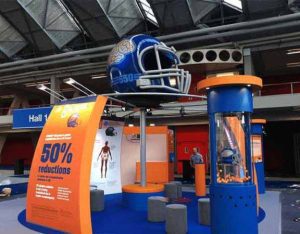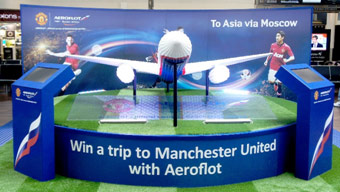
For many projects we embark upon, modern manufacturing technology gives us superior results compared to traditional methods. Using computer-assisted tools and design software can allow us to offer our clients more complex, better manufactured models for their commercial or display purposes. This blog post is about designing and manufacturing display models for clients.
Most businesses will need to have a display model manufactured at some point in their lifetime; whether to promote a new product, entice new customers or just to show off a bit, a large scale display model can wow crowds and drive sales.
We have a long history of manufacturing models for display purposes, ranging from large scale versions of products for sales purposes to bespoke one off installations in high-end stores. This has included models for pharmaceutical companies, exclusive fashion brands, as well as concept models for exhibitions and televised appearances.
One of the main advantages that modern technology has presented us is the use of CAD (Computer Aided Design) software; while previously we would have had to draw out complicated technical drawings of a project, CAD gives us the ability to plan out a project in great detail, giving us precise measurements and detailed 3Dimages to work to. It also allows us to present a rendered image of a finished model to a client, ensuring they are able to give any feedback before manufacturing has begun. CAD gives us the opportunity to test the structural and environmental properties of a model before manufacture; we can see where additional supports could be needed, or whether a model could survive high winds if it was hanging on the outside of a building. This helps us to minimise problems through
out manufacture, installation and beyond.
Using CAD for Display Models

Another advantage of utilising CAD in our manufacturing of display models is that it allows us to use the CAD to create other items, like rapid prototypes, lost wax castings, and fibreglass moulds. These items become much more cost effective for small scale production when employing CAD software.
Utilising both the CAD and our 5-axis milling machine, we can manufacture items from a wide variety of materials, creating designs that would have been too time consuming or expensive to manufacture by hand. This allows us to provide a wide range of expert services, including 3D printing, fibreglass manufacture, detailed prototypes and industrial concept models. Using CAD means different parts of projects can be manufactured using a variety of processes, with us being safe in the knowledge that the components will all fit together again; this saves the client time and money as it negates the need for trial and error manufacturing.
Using the CAD to manufacture items, as well as laser scanning to capture 3D images, allows us to utilise our bespoke model making skills at a scale that may have been unachievable previously. Our display models in the past have utilised 3D scanning to recreate footballers’ likenesses in a monumental homage to Mount Rushmore, scale up products over 200 times their original size, and create large scale models affixed to the back of cars to be driven around cities. This range of products achieved with 3D scanning illustrates our skill with using the technology and incorporating it into CAD software.
Staying up to date with modern technology has allowed us to streamline processes, speed up manufacture and offer more services to our clients. We’ve manufactured huge display models, used specialised and unusual materials, and manufactured 3D printed items that have astounded clients. If you think your next project could benefit from the best in bespoke model making and our excellent design engineers, email us at [email protected] or phone on 01277 365500.